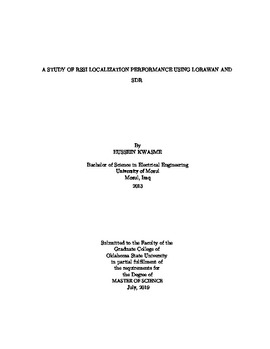| dc.contributor.advisor | Ekin, Sabit | |
| dc.contributor.author | Kwasme, Hussein | |
| dc.date.accessioned | 2020-01-30T19:46:48Z | |
| dc.date.available | 2020-01-30T19:46:48Z | |
| dc.date.issued | 2019-07 | |
| dc.identifier.uri | https://hdl.handle.net/11244/323415 | |
| dc.description.abstract | The Internet of Things (IoT) is increasing in size by having more devices connected to it as they are becoming low-cost to manufacture and easier to connect to the internet. New use cases are being created by the need for it and feasibility to provide it, with low-cost solutions. As a key enabler of IoT, Long Range Wide Area Network (LoRaWAN) is gaining great attention in research and industry. It provides a desirable solution for applications that require hundreds or thousands of actively connected devices to monitor a process or an environment or to assist in controlling a certain process. Some of these use cases require having the location information of these devices. In some cases, localization can be the intrinsic purpose of deployment. In this regard, the Received Signal Strength Indicator (RSSI) based localization offers a feasible and affordable solution. Since LoRaWAN has only been there for only a few years, research on utilizing LoRaWAN RSSI for localization purposes is in early stages and is scarce. In this paper, we study LoRaWAN RSSI based localization and evaluate its accuracy, impairments, and prospects. Additionally, we employ the use of Software Defined Radios (SDR) into our work for the purpose of path-loss characterization. Experimental results revealed the fact that a high variance of RSSI due to frequency hopping feature of LoRaWAN could severely impact the localization performance. Potential solutions are developed and presented to reduce this negative impact, hence improve the performance. | |
| dc.description.abstract | In our work, we study LoRaWAN IoT technology in terms of applicability in RSSI-based localization applications and show the range of localization error it produces. We utilized Software Defined Radios and implement them for accurate path-loss characterization. We show what possible localization applications are suitable for LoRaWAN, and how to improve its performance. | |
| dc.format | application/pdf | |
| dc.language | en_US | |
| dc.rights | Copyright is held by the author who has granted the Oklahoma State University Library the non-exclusive right to share this material in its institutional repository. Contact Digital Library Services at lib-dls@okstate.edu or 405-744-9161 for the permission policy on the use, reproduction or distribution of this material. | |
| dc.title | Study of RSSI Localization Performance Using LoRaWAN and SDR | |
| dc.contributor.committeeMember | Song, Ickhyun | |
| dc.contributor.committeeMember | Choi, Wooyeol | |
| osu.filename | Kwasme_okstate_0664M_16452.pdf | |
| osu.accesstype | Open Access | |
| dc.type.genre | Thesis | |
| dc.type.material | Text | |
| dc.subject.keywords | internet of things | |
| dc.subject.keywords | localization | |
| dc.subject.keywords | lorawan | |
| dc.subject.keywords | multilateration | |
| dc.subject.keywords | ranging | |
| dc.subject.keywords | rssi | |
| dc.subject.keywords | sdp | |
| dc.subject.keywords | usrp | |
| dc.subject.keywords | path-loss | |
| thesis.degree.discipline | Electrical Engineering | |
| thesis.degree.grantor | Oklahoma State University | |
